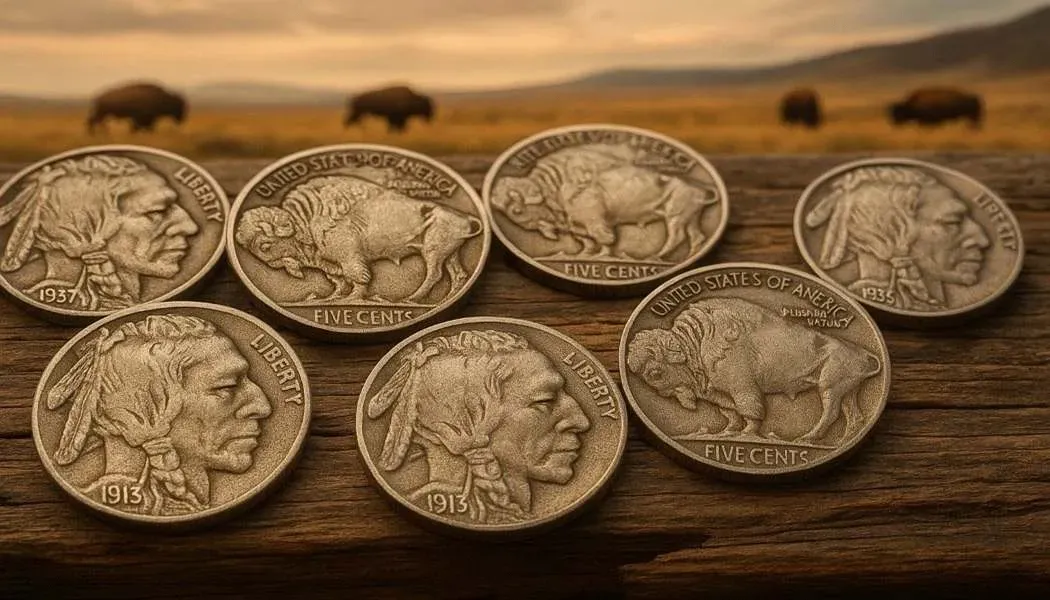Top 25 Most Valuable Buffalo Nickels and Their History

Top 25 Most Valuable Buffalo Nickels and Their History
The Buffalo Nickel: An Enduring Symbol of American Coinage
The Buffalo Nickel — officially the Indian Head Nickel — is one of the most beloved U.S. coins ever struck. Minted from 1913 through 1938, this five-cent piece captured the rugged spirit of the American West and paid homage to Native American culture. Its design, steeped in history and artistry, continues to inspire generations of collectors, historians, and investors seeking coins with lasting cultural significance and tangible value.
James Earle Fraser and the Story Behind the Design
Acclaimed sculptor James Earle Fraser, a former student of Augustus Saint-Gaudens, designed the Buffalo Nickel during a nationwide push to elevate the beauty of circulating coinage. Fraser envisioned a design uniquely American:
🔹 Obverse: A powerful right-facing profile created from a blend of three Native American chiefs — believed to include Iron Tail, Two Moons, and Big Tree. The portrait reflects strength, dignity, and heritage.
🔹 Reverse: A bold American bison, inspired by Black Diamond of New York’s Central Park Zoo, stands on a mound, symbolizing the untamed frontier.
Fraser’s composition ranks among the most iconic images in U.S. numismatics, celebrated for its depth, realism, and symbolism.
Why the Buffalo Nickel Was Replaced
Although admired for its artistry, the Buffalo Nickel suffered from technical flaws. Its high-relief details caused dies to wear quickly, and the raised date often vanished under circulation. To simplify production, the Jefferson Nickel debuted in 1938, offering a more durable, easily struck design. Despite its retirement, the Buffalo Nickel remains a cornerstone of American coin collecting, renowned for beauty, scarcity, and investment appeal.
The 25 Most Valuable Buffalo Nickels
Below is a ranking of the most coveted Buffalo Nickels, with approximate market values in top condition and notes on their appeal:
1. 1918/7-D Overdate – $350,000+: Famous overdate; rarest of the series.
2. 1916 Doubled Die Obverse – $300,000+: Dramatic doubling on inscriptions.
3. 1926-S – $250,000+: Lowest mintage; seldom found uncirculated.
4. 1913-S Type 2 – $175,000+: Scarce first-year San Francisco issue.
5. 1937-D 3-Legged – $125,000+: Legendary mint error missing one leg.
6. 1914/3 Overdate – $110,000+: Rare date punched over 1913.
7. 1924-S – $100,000+: Weakly struck; valuable in high grade.
8. 1913-S Type 1 – $90,000+: Early mound-reverse rarity.
9. 1935 Doubled Die Reverse – $85,000+: Doubling on lettering and bison.
10. 1915-S – $80,000+: Key low-mintage issue.
11. 1921-S – $75,000+: Post-WWI rarity with poor strikes.
12. 1917-S – $70,000+: Weak strikes and low survival rates.
13. 1927-S – $65,000+: Rare with sharp horn details.
14. 1919-S – $60,000+: Hard to find fully struck.
15. 1936-D 3½ Legs – $55,000+: Error from die polishing.
16. 1918-S – $50,000+: Weak strikes make top pieces scarce.
17. 1938-D/S – $45,000+: Over-mintmark rarity.
18. 1937-D Doubled Die Obverse – $40,000+: Clear date and lettering doubling.
19. 1913-D Type 2 – $35,000+: Denver’s first-year Type 2.
20. 1920-D – $30,000+: Limited survival in Mint State.
21. 1934-D – $25,000+: Low-grade strikes; rare in Gem.
22. 1923-S – $22,000+: Weakly struck but collectible in high grade.
23. 1938-D – $20,000+: Last-year issue; only Denver struck.
24. 1925-S – $18,000+: San Francisco rarity with soft detail.
25. 1929-S – $15,000+: Common mintage but few survive sharp.
Note on Values:
Values reflect high-grade examples; prices can fluctuate widely depending on a coin’s condition, rarity, and current market demand. Pedigree and provenance also play an important role — coins tied to famous collections or auctions often command premiums. Even minor differences in strike quality, luster, or eye appeal may significantly influence price. For the most accurate assessment, consult a reputable grading service or professional numismatic appraiser before buying or selling.
Collecting Buffalo Nickels: Tips for Success
Buffalo Nickels reward patience and expertise:
🔹 Seek Strong Strikes: “Full horn” details on the bison’s head signal quality.
🔹 Prioritize Key Dates: 1913-S, 1918/7-D, 1926-S, and major errors hold long-term value.
🔹 Certification Matters: PCGS or NGC grading safeguards authenticity and helps preserve resale value.
🔹 Watch for Counterfeits: Altered dates and replicas exist; source from trusted dealers.
🔹 Store Safely: Use holders or slabs to prevent wear and protect luster.
Lasting Allure of the Buffalo Nickel
The Buffalo Nickel stands as a testament to American artistry and frontier history. From overdates to dramatic errors, the series offers collectors an engaging mix of rarity, design, and cultural heritage. Its top specimens fetch six-figure sums, proving how enduring narratives and scarcity can transform everyday change into coveted treasures. Whether assembling a complete set or hunting elusive key dates, Buffalo Nickels remain a rewarding gateway into the world of classic U.S. coinage — a blend of history, beauty, and enduring value.
Oher articles that may interest you:
1943 Copper Wheat Penny: The Legendary Lincoln Error Coin
Collectible U.S. Quarters: Rarity, Errors & Value Guide